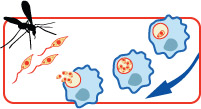|
Leishmaniasis is a parasitic disease transmitted by the bite of infected sand flies. It is found in nearly 88 countries, from rain forests in Central and South America to deserts in the Middle East and west Asia. Some cases of the disease have also appeared in Mexico and Texas.
Leishmaniasis takes several different forms, including the most common cutaneous leishmaniasis, which causes skin sores, and the more severe visceral leishmaniasis, which affects internal organs such as the spleen, liver, and bone marrow.
NIAID Leishmaniasis Research Program
NIAID conducts and support leishmaniasis research to advance the understanding of all aspects of the disease, including the different species of disease-causing Leishmania parasites, the varieties of sand flies that transmit the parasites to animals and humans, and how the host immune system responds to the infection.
| The World Health Organization (WHO) estimates that there are 1.5 million new cases of cutaneous leishmaniasis and 500,000 new cases of visceral leishmaniasis in the world each year.
Leishmaniasis Life Cycle

View an illustration about the life cycle of leishmaniasis.
News Releases
Researchers Find Leishmaniasis Parasites Evade Death by Exploiting the Immune Response to Sand Fly Bites—Aug. 14, 2008
NIAID Media Availability: Neglected Tropical Diseases Burden Those Overseas, But Travelers Also at Risk—Dec. 26, 2007
Three Deadly Parasite Genomes Sequenced—July 14, 2005
All Parasitic Infections News Releases |